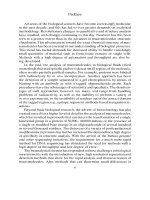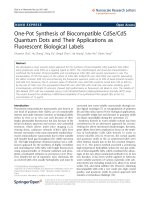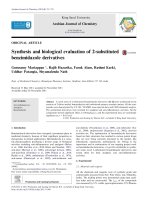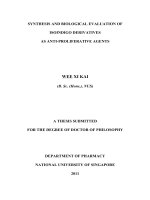Synthesis of Biological Macromolecules
Bạn đang xem bản rút gọn của tài liệu. Xem và tải ngay bản đầy đủ của tài liệu tại đây (286.77 KB, 4 trang )
Synthesis of Biological Macromolecules
Synthesis of Biological
Macromolecules
Bởi:
OpenStaxCollege
As you’ve learned, biological macromolecules are large molecules, necessary for life,
that are built from smaller organic molecules. There are four major classes of biological
macromolecules (carbohydrates, lipids, proteins, and nucleic acids); each is an
important cell component and performs a wide array of functions. Combined, these
molecules make up the majority of a cell’s dry mass (recall that water makes up
the majority of its complete mass). Biological macromolecules are organic, meaning
they contain carbon. In addition, they may contain hydrogen, oxygen, nitrogen, and
additional minor elements.
Dehydration Synthesis
Most macromolecules are made from single subunits, or building blocks, called
monomers. The monomers combine with each other using covalent bonds to form
larger molecules known as polymers. In doing so, monomers release water molecules as
byproducts. This type of reaction is known as dehydration synthesis, which means “to
put together while losing water.”
In the dehydration synthesis reaction depicted above, two molecules of glucose are linked
together to form the dissacharide maltose. In the process, a water molecule is formed.
In a dehydration synthesis reaction ([link]), the hydrogen of one monomer combines
with the hydroxyl group of another monomer, releasing a molecule of water. At the same
time, the monomers share electrons and form covalent bonds. As additional monomers
join, this chain of repeating monomers forms a polymer. Different types of monomers
1/4
Synthesis of Biological Macromolecules
can combine in many configurations, giving rise to a diverse group of macromolecules.
Even one kind of monomer can combine in a variety of ways to form several different
polymers: for example, glucose monomers are the constituents of starch, glycogen, and
cellulose.
Hydrolysis
Polymers are broken down into monomers in a process known as hydrolysis, which
means “to split water,” a reaction in which a water molecule is used during the
breakdown ([link]). During these reactions, the polymer is broken into two components:
one part gains a hydrogen atom (H+) and the other gains a hydroxyl molecule (OH–)
from a split water molecule.
In the dehydration reaction shown here, the disaccharide maltose is broken down to form two
glucose monomers. Note that this reaction is the reverse of the synthesis reaction shown in
[link].
Dehydration and hydrolysis reactions are catalyzed, or “sped up,” by specific enzymes;
dehydration reactions involve the formation of new bonds, requiring energy, while
hydrolysis reactions break bonds and release energy. These reactions are similar for
most macromolecules, but each monomer and polymer reaction is specific for its class.
For example, in our bodies, food is hydrolyzed, or broken down, into smaller molecules
by catalytic enzymes in the digestive system. This allows for easy absorption of
nutrients by cells in the intestine. Each macromolecule is broken down by a specific
enzyme. For instance, carbohydrates are broken down by amylase, sucrase, lactase,
or maltase. Proteins are broken down by the enzymes pepsin and peptidase, and by
hydrochloric acid. Lipids are broken down by lipases. Breakdown of these
macromolecules provides energy for cellular activities.
Link to Learning
2/4
Synthesis of Biological Macromolecules
Visit this site to see visual representations of dehydration synthesis and hydrolysis.
Section Summary
Proteins, carbohydrates, nucleic acids, and lipids are the four major classes of biological
macromolecules—large molecules necessary for life that are built from smaller organic
molecules. Macromolecules are made up of single units known as monomers that are
joined by covalent bonds to form larger polymers. The polymer is more than the sum
of its parts: it acquires new characteristics, and leads to an osmotic pressure that is
much lower than that formed by its ingredients; this is an important advantage in the
maintenance of cellular osmotic conditions. A monomer joins with another monomer
with the release of a water molecule, leading to the formation of a covalent bond. These
types of reactions are known as dehydration or condensation reactions. When polymers
are broken down into smaller units (monomers), a molecule of water is used for each
bond broken by these reactions; such reactions are known as hydrolysis reactions.
Dehydration and hydrolysis reactions are similar for all macromolecules, but each
monomer and polymer reaction is specific to its class. Dehydration reactions typically
require an investment of energy for new bond formation, while hydrolysis reactions
typically release energy by breaking bonds.
Review Questions
Dehydration synthesis leads to formation of
1.
2.
3.
4.
monomers
polymers
water and polymers
none of the above
B
During the breakdown of polymers, which of the following reactions takes place?
1.
2.
3.
4.
hydrolysis
dehydration
condensation
covalent bond
A
Free Response
Why are biological macromolecules considered organic?
3/4
Synthesis of Biological Macromolecules
Biological macromolecules are organic because they contain carbon.
What role do electrons play in dehydration synthesis and hydrolysis?
In a dehydration synthesis reaction, the hydrogen of one monomer combines with the
hydroxyl group of another monomer, releasing a molecule of water. This creates an
opening in the outer shells of atoms in the monomers, which can share electrons and
form covalent bonds.
4/4









